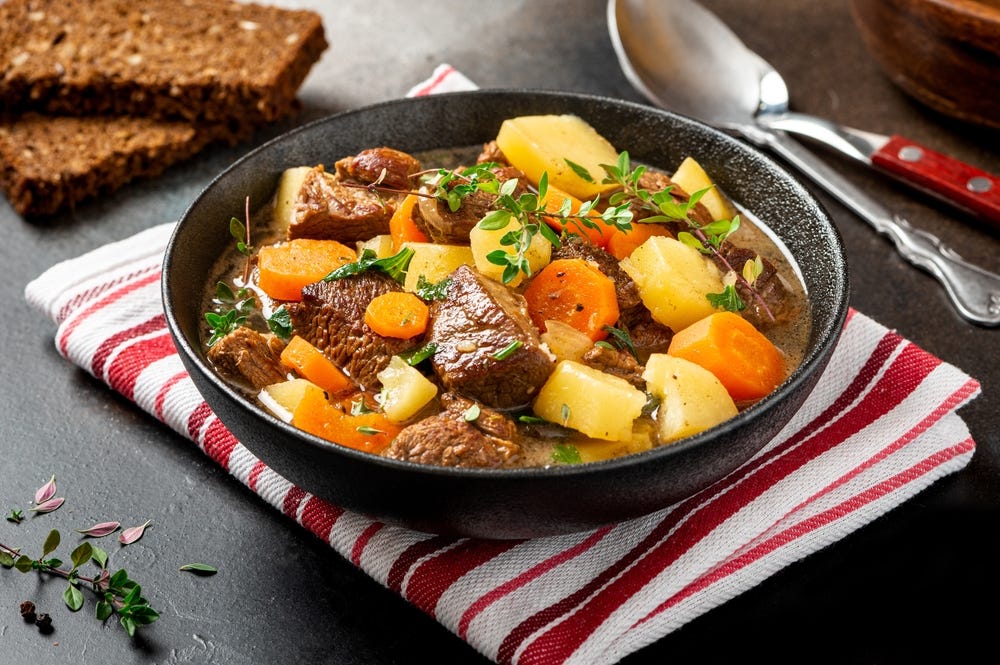Traditional Irish Stew: A Timeless Comfort Food
Perfect For Those Autumn Days
Traditional Irish Stew: A Timeless Comfort Food
Irish stew is one of Ireland’s most cherished dishes, embodying the heart and soul of Irish cooking. Simple yet rich in flavour, this hearty stew has been enjoyed for centuries, offering warmth and sustenance on cold days. Traditionally made with just a few basic ingredients — lamb or mutton, potatoes, onions, and carrots — Irish stew has remained a staple in Irish households thanks to its wholesome simplicity.
A Dish Born of Necessity
The origins of Irish stew are humble, rooted in the necessity of making the most of available resources. Irish farmers and peasants would use whatever meat they had, which was often tough cuts of lamb or mutton, and cook them slowly with potatoes and root vegetables. This long cooking process helped tenderise the meat, while the vegetables and potatoes created a thick, flavourful broth. Over time, Irish stew became a symbol of comfort and community, served during family gatherings and special occasions.
Ingredients for a Traditional Irish Stew
The beauty of Irish stew lies in its simplicity. Only a handful of ingredients are required, and the method is straightforward, making it a great dish for both beginners and seasoned cooks alike. While some variations exist, the traditional version remains a favourite for its rustic charm and deep, satisfying flavours.
Ingredients (serves 4–6):
- 1.5 lbs (700g) of lamb shoulder or neck, cut into chunks (bone-in for added flavor)
- 1.5 lbs (700g) of potatoes, peeled and halved (use floury potatoes like Maris Piper)
- 2 large carrots, peeled and chopped into chunks
- 2 large onions, chopped into quarters
- 3–4 cups (750ml – 1 liter) of beef or lamb stock (or water)
- 2–3 sprigs of fresh thyme
- 1 bay leaf
- Salt and freshly ground black pepper
- Fresh parsley, chopped (for garnish)
Method
1.Prepare the Meat
Start by trimming any excess fat from the lamb. Traditionally, bone-in lamb shoulder or neck is used for the richest flavour, but boneless lamb works well too. The fat rendered during cooking gives the stew its characteristic depth.
2.Layer the Ingredients
In a large, heavy-bottomed pot or Dutch oven, layer the ingredients. Begin by placing a layer of lamb at the bottom, followed by a layer of onions, carrots, and potatoes. Repeat this process, layering the remaining lamb and vegetables.
3.Season and Add Herbs
Season the stew generously with salt and freshly ground black pepper. Add the thyme sprigs and bay leaf, tucking them into the layers.
4.Add the Stock
Pour the stock over the layers, ensuring that it covers the meat and vegetables. If necessary, add more stock or water until everything is just submerged. Using lamb stock enhances the flavour, but beef or vegetable stock works well as a substitute.
5.Slow Cook the Stew
Bring the pot to a gentle simmer over medium heat. Once simmering, reduce the heat to low, cover the pot with a lid, and allow the stew to cook slowly for 2 to 2.5 hours. Stir occasionally to ensure nothing sticks to the bottom. The key to a perfect Irish stew is low and slow cooking, which allows the flavors to meld and the meat to become tender.
6.Check
After about 2 hours, check the stew. The lamb should be tender and falling apart, and the potatoes soft and flavourful, having absorbed the savoury broth. If the stew is too thick, you can add a little more water or stock to loosen it.
7.Final Touches
Remove the thyme sprigs and bay leaf. Taste the stew and adjust the seasoning with more salt and pepper if necessary. Just before serving, garnish with freshly chopped parsley for a pop of colour and freshness.
Serving Suggestions
Irish stew is best enjoyed with a side of rustic bread, such as traditional Irish soda bread, to mop up the delicious broth. It’s also often served with a pint of Guinness, which complements the rich, earthy flavours of the stew. This dish is perfect for cold autumn or winter days and is often made in large batches to feed a crowd or to reheat as leftovers — the flavoor only improves the next day!
Tips for the Perfect Irish Stew
-Use bone-in meat: For a more traditional approach and added flavor, use lamb or mutton with the bone in. The bones release gelatin during cooking, creating a richer broth.
-Potato varieties: Floury potatoes, like Maris Piper or Russets, work best because they break down slightly during cooking, thickening the stew. If you prefer your potatoes to hold their shape, waxy varieties such as Yukon Golds are a good choice.
-Slow cooking is key: Low and slow cooking allows the flavors to develop fully. While it’s tempting to rush, give the stew the time it needs to become tender and deeply flavourful.
-Optional additions: While traditional Irish stew keeps things simple, modern variations may include ingredients like leeks, celery, or even pearl barley to add texture and nutrition.
A Dish That Stands the Test of Time
Irish stew is more than just a meal — it’s a reflection of Ireland’s history, culture, and the resourcefulness of its people. Whether you're cooking for a family dinner or just craving a bit of comfort, Irish stew brings warmth and nourishment to the table with every spoonful. As the days grow colder and the nights longer, there's nothing better than gathering around a pot of this traditional stew to share with loved ones.
Enjoy your own taste of Ireland with this timeless, hearty dish!
It is clear that our group members love their Irish Food.
Please feel free to add your own comments and please share any recipes you might have. We are always looking for those “family secrets”.




